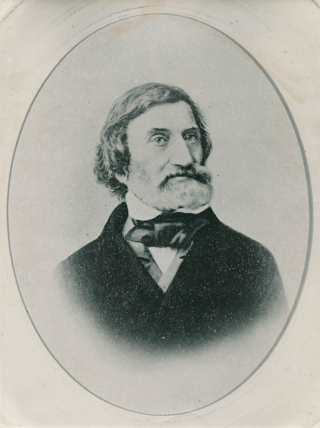
Friedrich Wilhelm Bessel was a German astronomer, mathematician, physicist, and geodesist. He was the first astronomer who determined reliable values for the distance from the sun to another star by the method of parallax. Certain important mathematical functions were named Bessel functions after Bessel's death, though they had originally been discovered by Daniel Bernoulli before being generalised by Bessel.

Jena is a city in Germany and the second largest city in Thuringia. Together with the nearby cities of Erfurt and Weimar, it forms the central metropolitan area of Thuringia with approximately 500,000 inhabitants, while the city itself has a population of about 110,000. Jena is a centre of education and research; the university was founded in 1558 and had 18,000 students in 2017 and the Ernst-Abbe-Fachhochschule Jena counts another 5,000 students. Furthermore, there are many institutes of the leading German research societies.

Wilhelm Eduard Weber was a German physicist and, together with Carl Friedrich Gauss, inventor of the first electromagnetic telegraph.

Carl Zeiss was a German scientific instrument maker, optician and businessman. In 1846 he founded his workshop, which is still in business as Carl Zeiss AG. Zeiss gathered a group of gifted practical and theoretical opticians and glass makers to reshape most aspects of optical instrument production. His collaboration with Ernst Abbe revolutionized optical theory and practical design of microscopes. Their quest to extend these advances brought Otto Schott into the enterprises to revolutionize optical glass manufacture. The firm of Carl Zeiss grew to one of the largest and most respected optical firms in the world.

Johann Gottfried Galle was a German astronomer from Radis, Germany, at the Berlin Observatory who, on 23 September 1846, with the assistance of student Heinrich Louis d'Arrest, was the first person to view the planet Neptune and know what he was looking at. Urbain Le Verrier had predicted the existence and position of Neptune, and sent the coordinates to Galle, asking him to verify. Galle found Neptune in the same night he received Le Verrier's letter, within 1° of the predicted position. The discovery of Neptune is widely regarded as a dramatic validation of celestial mechanics, and is one of the most remarkable moments of 19th-century science.

Ernst Karl Abbe was a German businessman, optical engineer, physicist, and social reformer. Together with Otto Schott and Carl Zeiss, he developed numerous optical instruments. He was also a co-owner of Carl Zeiss AG, a German manufacturer of scientific microscopes, astronomical telescopes, planetariums, and other advanced optical systems.

Maximilian Franz Joseph Cornelius Wolf was a German astronomer and a pioneer in the field of astrophotography. He was the chairman of astronomy at the University of Heidelberg and director of the Heidelberg-Königstuhl State Observatory from 1902 until his death in 1932.

Cuno Hoffmeister was a German astronomer, observer and discoverer of variable stars, comets and minor planets, and founder of Sonneberg Observatory.

Johann Friedrich Julius Schmidt was a German astronomer and geophysicist. He was the director of the National Observatory of Athens in Greece from 1858 to 1884. Julius Schmidt was tireless in his work, it was suggested by William Henry Pickering that he perhaps devoted more of his life than any other man to the study of the Moon. During his lifetime, he made some of the most complete lunar maps of the 19th century.

Johann Georg Repsold was a German manufacturer of scientific instruments, astronomer, and fireman. He began to make astronomic instruments mainly for his own use. His third son Adolf Repsold continued the well-known astronomical instrument firm as the A. & G. Repsold company, which later became A. Repsold und Söhne.

Schott AG is a German multinational glass company specializing in the manufacture of glass and glass-ceramics. Headquartered in Mainz, Germany, it is owned by the Carl Zeiss Foundation. The company's founder and namesake, Otto Schott, is credited with the invention of borosilicate glass.

Carl Ludwig Christian Rümker was a German astronomer.

Wilhelm Roux was a German zoologist and pioneer of experimental embryology.

The Berlin Observatory is a German astronomical institution with a series of observatories and related organizations in and around the city of Berlin in Germany, starting from the 18th century. It has its origins in 1700 when Gottfried Leibniz initiated the "Brandenburg Society of Science″ which would later (1744) become the Prussian Academy of Sciences. The Society had no observatory but nevertheless an astronomer, Gottfried Kirch, who observed from a private observatory in Berlin. A first small observatory was furnished in 1711, financing itself by calendrical computations.

Leibniz Institute for Astrophysics Potsdam (AIP) is a German research institute. It is the successor of the Berlin Observatory founded in 1700 and of the Astrophysical Observatory Potsdam (AOP) founded in 1874. The latter was the world's first observatory to emphasize explicitly the research area of astrophysics. The AIP was founded in 1992, in a re-structuring following the German reunification.

Johann Wilhelm Wagner was a German astronomer.

The Altona Observatory was an astronomical observatory situated in the Palmaille, in Altona, Hamburg. The observatory was founded by Heinrich Christian Schumacher in 1823 and continued to operate until 1871, 21 years after his death. It closed due to funding being cut off following the cession of the 'Elbe Duchies' of Schleswig, Holstein, and Saxe-Lauenburg by Denmark to Austria and Prussia following the Second Schleswig War.

Potsdam Great Refractor is an historic astronomical telescope in an observatory in Potsdam, Germany.

The Bamberg-Refraktor is a large telescope. The refracting telescope has an aperture of 320 millimetres, a focal length of five metres and is located in the Wilhelm Foerster Observatory in the Berlin district of Schöneberg.

The Wilhelm Foerster Observatory in Berlin is a large public observatory which allows visitors to observe the sky through several telescopes. The facility is named after the German astronomer Wilhelm Foerster.



















